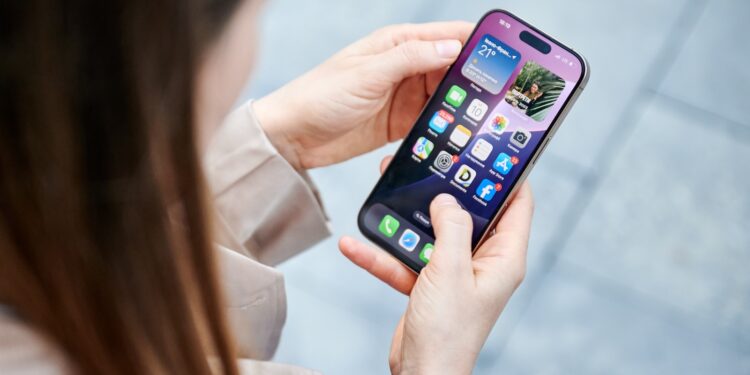If you want to make your home screen clearer and more personalized, widgets on the iPhone are an effective way to do this. They display important information directly on the home screen and can be customized to your needs in just a few steps. You can make your iPhone more functional and personalized at the same time, without the need for additional apps.
Widgets are one of your iPhone's practical standard features. Whether it's the calendar, weather, reminders, or app shortcuts, widgets let you keep an eye on important content without having to open an app first. Widgets can also be customized in size, position, and sometimes even their appearance. With a little time, you can create a personalized dashboard that perfectly fits your everyday life. The following six ideas will help you design your iPhone widgets in a meaningful and visually appealing way.
Stack widgets and save space
With widget stacks, you can layer multiple widgets on top of each other and switch between them with a swipe gesture. To do this, hold down a widget until it wobbles, then drag it onto another widget of the same size. This creates a stack that can be customized as needed. You can bundle various information like the calendar, weather, and to-do list in one place without cluttering the entire home screen. This is especially useful when you need a lot of content but don't want to use much space.
Use personal photos as widget background
The photo widget lets you display your own images directly on your home screen. You can select specific photos or simply create an album from which the widget randomly switches images. This is ideal if you want to keep an eye on your family, friends, or favorite moments. The large widgets (4x4) are particularly eye-catching and can be placed prominently. You can customize the photo selection under "Photos" and "For You," or you can create a special album for use only with the widget.
Use Smart Stack for context-dependent information
The Smart Stack automatically shows you the right widgets at the right time. For example, your calendar appears in the morning, the weather during the day, and your Activity Rings in the evening. The iPhone analyzes your usage and adjusts the display accordingly. You can also add or remove your own widgets from the Smart Stack. To do so, tap the stack, select "Edit Stack," and manually adjust the order or visibility. This way, you get dynamic content without any additional effort.
Consistent colors and layouts for a tidy look
If you use multiple widgets on your home screen, it's worth maintaining a consistent color scheme. For example, choose similar background colors or icons that match your wallpaper. This not only creates a calmer appearance but also helps with orientation. Some apps allow you to customize widget colors. If you prefer minimalism or clean designs, this allows you to create a harmonious overall look without sacrificing functionality.
Set up shortcuts as widgets for frequent actions
Using the Shortcuts app, you can create your own automations and place them directly on your home screen as widgets. For example, you can start music, start navigation, or control your smart home with a single tap. The advantage: You save time and don't have to navigate through menus. Even complex processes like "start commute" with multiple actions in succession can be implemented this way. This is especially useful for routines you use every day.
Use third-party widgets for special functions
If the standard features aren't enough for you, there are numerous third-party apps in the App Store that offer advanced widget features. Popular ones include Widgetsmith, Carrot Weather, and Scriptable. These apps let you create your own designs, display detailed weather data, or even program your own scripts. These apps usually offer more customization options than Apple's standard widgets. You can also customize the layout, font size, or data source.
Combine and use iPhone widgets cleverly
With the right settings and a little planning, you can customize your iPhone widgets and significantly enhance your home screen. Whether through stacked widgets, personal photos, intelligent content, matching color schemes, smart shortcuts, or specialized third-party apps – your iPhone will not only be more organized, but also much better tailored to your everyday life. Experiment with different combinations and find out what works best for you. The best products for you: Our Amazon storefront offers a wide selection of accessories, including those for HomeKit. (Image: Shutterstock / anatoliy_gleb)
- Set up Apple Pay on your iPhone – quickly and securely
- Why an iPhone? These advantages are convincing in the long term
- Secure your iPhone properly: 5 important functions at a glance
- Save iPhone battery: When is power saving mode worth it?
- Use Apple Wallet safely, conveniently, and efficiently – 7 tips
- LG or Samsung Smart TV? How to disable tracking
Using iPhone widgets cleverly – frequently asked questions explained
Press and hold an empty space on your home screen until the app icons wiggle. Then tap the plus sign in the top left, select a widget from the list, and drag it to your screen.
A widget stack is a manually created collection of similarly sized widgets that you can switch between with a swipe gesture. The Smart Stack works similarly, but automatically displays relevant content based on the time of day or usage.
Yes. When you add a widget, you can choose from different sizes (e.g., small, medium, large). After adding it, you'll need to remove the widget and add it again in a different size if you want to change it.
Use the photo widget and select a specific album or individual images. It's best to create a separate album in the Photos app that you use specifically for the widget.
You'll need the pre-installed Shortcuts app. There, you can create your own automations and execute them directly from the widget.
Yes. Popular apps like Widgetsmith, Carrot Weather, and Scriptable offer significantly more design options and specialized features.
Press and hold the Smart Stack and select "Edit Stack." There you can add, remove, or change the order of widgets.
The Smart Stack adapts to your usage behavior. If you don't want to see certain content, you can deactivate it or remove it from the stack.
Some apps (like Widgetsmith or calendar apps) offer color customization. A consistent color scheme creates a cleaner home screen.
There's no hard limit, but too many widgets can look cluttered. Use widget stacks to save space while still having plenty of information at your fingertips.





